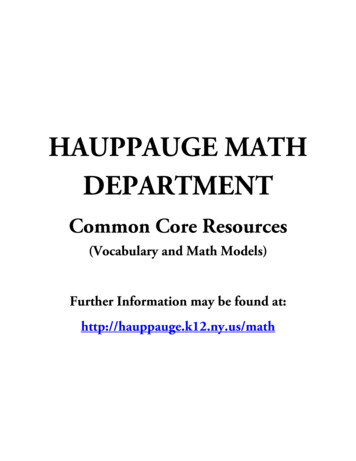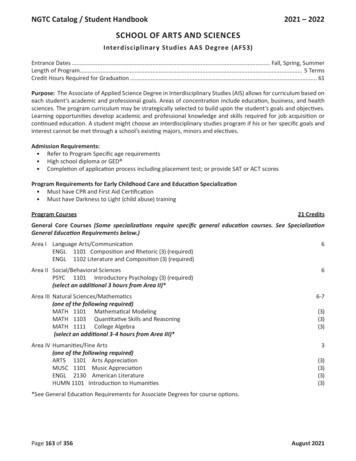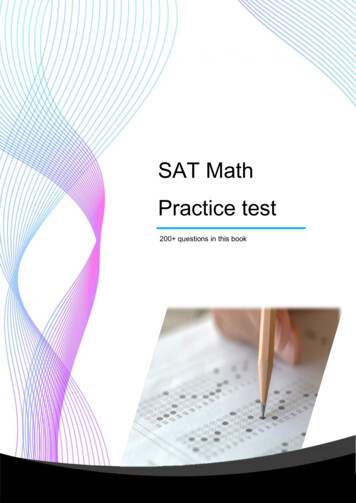
Transcription
HAUPPAUGE MATHDEPARTMENTCommon Core Resources(Vocabulary and Math Models)Further Information may be found at:http://hauppauge.k12.ny.us/math
Hauppauge School DistrictVocabulary for the Common Core Math ModulesThis vocabulary list will be updated after additional modules are released by the NewYork State Education Department.KindergartenModule 1 New or Recently Introduced TermsExactly the same/not exactly the same/the same, but (ways to analyze objects to match or sort)Match (group items that are the same or that have the same given attribute)Sort (group objects according to a particular attribute)“How many” (with reference to counting quantities or sets)Hidden partners (embedded numbers)Counting path (with reference to order of count)Number story (stories with add to or take from situations)Zero (understand the meaning of, write and recognize)Number sentence (3 2 1)5-groupRows/columns (linear configuration types)Number path1 more (e.g., 4. 1 more is 5)1 less (e.g., 4. 1 less is 3)Module 2 New or Recently Introduced TermsAbove, below, beside, in front of, next to, behind (position words)CircleCube (three-dimensional shape)Cylinder (three-dimensional shape)Face (flat side of a solid)Flat (two-dimensional shape)Hexagon (flat figure enclosed by six straight sides)Rectangle (flat figure enclosed by four straight sides)Solid (three-dimensional shape)Cone (three-dimensional shape)Sphere (three-dimensional shape)Square (flat figure enclosed by four straight, equal sides)Triangle (flat figure enclosed by three straight sides)Familiar Terms and SymbolsMatch (group items that are the same or that have the same given attribute)Sort
Module 3 New or Recently Introduced TermsBalance scale (tool for weight measurement)Capacity (with reference to volume)Compare (specifically using direct comparison)Endpoint (with reference to alignment for direct comparison)Enough/not enough (comparative term)Heavier than/lighter than (weight comparison)Height (vertical distance measurement from bottom to top)Length (distance measurement from end to end; in a rectangular shape, length can be used to describe any of the foursides)Longer than/shorter than (length comparison)More than/fewer than (discrete quantity comparison)More than/less than (volume, area, and number comparisons)Taller than/shorter than (height comparison)The same as (comparative term)Weight (heaviness measurement)Familiar Terms and SymbolsMatch (group items that are the same or that have the same given attribute)Numbers 1–10Module 5 New or Recently Introduced TermsSay Ten counting by tens to 100 (i.e., 1 ten, 2 tens, 3 tens, 4 tens, 5 tens, 6 tens, 7 tens, 8 tens, 9 tens, 10 tens)Regular counting by ones from 11 – 20 (i.e., eleven, twelve, thirteen,etc.)Regular counting by tens to 100 (i.e., ten, twenty, thirty, forty, fifty, sixty, seventy, eighty, ninety, one hundred)Hide Zero cards (in later grades called Place Value cards, pictured to the right)10 ones and some onesTeen numbers10 and10 plusFamiliar Terms and SymbolsCount 10 onesCircle 10 onesCircular countNumber towerNumber bondPart, whole, totalDot path, empty path, number pathScatter count5-group10-frameLinear countSay Ten counting (e.g. , 11–20 is spoken as “ten one, ten two, ten three, ten four, ten five, ten six,ten seven, ten eight, ten nine, two ten”)
First GradeModule 1 New or Recently Introduced TermsCount on (Students count up from one addend to the total.)Track (Students use different objects to track the count on from one addend to the total.)Expression (e.g., 2 1 or 5 5.)Addend (One of the numbers being added.)Doubles (e.g., 3 3 or 4 4.)Doubles plus 1 (e.g., 3 4 or 4 5.)Familiar Terms and SymbolsPart (e.g., “What is the unknown part? 3 8”)Total and whole (“What is the total when we add 3 and 5?” Use interchangeablyinstead of sum.) partpartNumber BondNumber PathLabel (Students label math drawings using letters or words to indicate the referents from thestory’s context.)Addition, equal, and subtraction signsEquation and number sentence (Use interchangeably throughoutthe module.)Number Bond, a graphic showing part/part/wholeEqual sign ( )5-groups (as pictured in the dot cards to the right), 2 rows of 5Module 2 wholeNew or Recently Introduced TermsA ten (Students will focus mainly on one ten during this module.)Ones (These are individual units, ten of which become a ten.)Familiar Terms and Symbolswhole5-GroupsAddEqualsNumber bondspartpartPartners to tenSubtractNumber BondTeen numbersRekenrekHide Zero Cards
Module 3 New or Recently Introduced TermsCentimeter (standard length unit within the metric system)Centimeter cube (pictured right)Length unit (measuring the length of an object with equal-sized units)Familiar Terms and SymbolsLess thanLonger thanMore thanShorter thanModule 4 New or Recently Introduced Terms (greater than) (less than)Place value (quantity represented by a digit in a particular place within a number)Familiar Terms and SymbolsEqual ( )NumeralsOnesTens
Second GradeModule 1 Familiar Terms and SymbolsMake ten and subtract from ten (e.g., 8 3 8 2 1 and 15 – 7 10 – 7 5 3 5)Ten plus (e.g., 10 3 13, 30 5 35, 70 8 78)Number bond (e.g., 5 1 6, 1 5 6, 6 – 1 5, 6 – 5 1)Say Ten counting (e.g., 11 is “1 ten 1,” 12 is “1 ten 2,” twenty is “2 tens,” 27 is “2 tens 7,” 35 is “3 tens 5,” 100 is “1hundred,” 146 is “1 hundred 4 tens 6”)Module 2 New or Recently Introduced TermsEndpoint (where something ends, where measurement begins)Overlap (extend over, or cover partly)RulerCentimeter (cm, unit of length measure)MeterMeter strip (pictured to the right)Meter stickHash mark (the marks on a ruler or other measurement tool)Number line (a line marked at evenly spaced intervals)Estimate (an approximation of the value of a quantity or number)Benchmark (e.g., “round” numbers like multiples of 10)Familiar Terms and SymbolsLengthHeightLength UnitCombineCompareDifferenceTape DiagramMeter Strip
Module 3 New or Recently Introduced TermsBase ten numerals (e.g., a thousand is 10 tens, a hundred is 10 ones, starting in Grade 3 a one is 10 tenths, etc.)Expanded form (e.g., 500 70 6)Hundreds place (e.g., the 5 in 576; tells how many hundreds are in a number)One thousand (1,000)Place value or number disk (pictured to the right)Standard form (e.g., 576)Word form (e.g., five hundred seventy-six)Familiar Terms and Symbols , , (equal, less than, greater than)Altogether (e.g., 59 centimeters and 17 centimeters; altogether there are 76 centimeters)Bundling, grouping (putting smaller units together to make a larger one, e.g., putting 10 ones together to make a ten or 10tens together to make a hundred)How many more/less (the difference between quantities)How much more/less (the difference between quantities)More than/less than (e.g., 576 is more than 76; 76 is less than 576)Number sentenceOnes place (e.g., the 6 in 576; tells how many ones are in a number)Place value (the unitary values of the digits in numbers)Renaming, changing (instead of “carrying” or “borrowing,” e.g., a group of 10 ones is “renamed” a ten when the ones arebundled and moved from the ones to the tens place; if using 1 bills, they may be “changed” for a 10 bill when there areenough)Tens place (e.g., the 7 in 576; tells how many tens are in a number)Unit form counting (unit form counting states the amount of hundreds, tens, and ones in each number, e.g., 11 is stated as1 ten 1 one, 20 as 2 tens, 27 as 2 tens 7 ones, 100 as 1 hundred, and 146 as 1 hundred 4 tens 6 ones.)Units of ones, tens, hundreds, one thousand (a single one and groups of 10s, 100s, and 1,000)Module 4New or Recently Introduced Terms EquationMinuendNew groups belowPlace value chart (pictured below right)Place value or number disk (pictured to the right)SubtrahendTotals belowPlace Value Chart with Headings(use with numbers)hundredstensones726Place Value Chart without Headings(use with number disks)Familiar Terms and SymbolsAddend, Addition, DifferenceBundle, unbundle, regroup, rename, change (compose ordecompose a 10 or 100)Hundreds place (referring to place value)SubtractionUnits of ones, tens, hundreds, thousands (referring to place value; 10 ones is the same as 1 unit of ten)Place value (referring to the unit value of each digit in a given number)
Grade 3Module 1New or Recently Introduced TermsArray (a set of numbers or objects that follow a specific pattern, a matrix)Column (e.g., in an array)Commutative Property/Commutative (e.g., rotate a rectangular array 90 degrees to demonstrate that factors in amultiplication sentence can switch places)Equal groups (with reference to multiplication and division; one factor is the number of objects in a group and the other is amultiplier that indicates the number of groups)Equation (a statement that 2 expressions are equal. E.g., 3 4 12)Distribute (with reference to the Distributive Property; e.g. In 12 3 (10 3) (2 3) the 3 is multiplier for each part ofthe decomposition)Divide/division (partitioning a total into equal groups to show how many equal groups add up to a specific number. E.g., 15 5 3)Fact (used to refer to multiplication facts, e.g., 3 2)Factors (i.e., numbers that are multiplied to obtain a product)Multiplication/multiply (an operation showing how many times a number is added to itself e.g., 5 3 15)Number of groups (factor in a multiplication problem that refers to the total equal groups)Parentheses (e.g., ( ) used around a fact or numbers within an equation)Quotient (the answer when one number is divided by another)Rotate (turn, used with reference to turning arrays 90 degrees)Row/column (in reference to rectangular arrays)Size of groups (factor in a multiplication problem that refers to how many in a group)Unit (i.e., one segment of a partitioned tape diagram)Unknown (i.e., the “missing” factor or quantity in multiplication or division)Familiar Terms and SymbolsAdd 1 unit, subtract 1 unit (add or subtract a single unit of two, ten, etc.)Number bond (shows part-part-whole relationship, shown at right)Number sentence (similar to an equation, but not necessarily having equal sides.)Ones, twos, threes, etc. (units of one, two, or three)Repeated addition (adding equal groups together, e.g., 2 2 2 2)Tape Diagram (a method for modeling problems)Value (how much) Module 2 New or Recently Introduced Terms and SymbolsAbout (with reference to rounding and estimation, an answer that is not precise)Addend (the numbers that are added together in an addition equation, e.g., in 4 5, the numbers 4 and 5 are the addends)Analog clock (a clock that is not digital)Capacity (the amount of liquid that a particular container can hold)Compose (change 10 smaller units for 1 of the next larger unit on the place value chart)Continuous (with reference to time as a continuous measurement)Endpoint (used with rounding on the number line; the numbers that mark the beginning and end of a given interval)Gram (g, unit of measure for weight)Halfway (with reference to a number line, the midpoint between two numbers, e.g., 5 is halfway between 0 and 10)Interval (time passed or a segment on the number line)Kilogram (kg, unit of measure for mass)Liquid volume (the space a liquid takes up)
Liter (L, unit of measure for liquid volume)Milliliter (mL, unit of measure for liquid volume)Plot (locate and label a point on a number line)Point (a specific location on the number line)Reasonable (with reference to how plausible an answer is, e.g., “Is your answer reasonable?”)Rename (regroup units, e.g., when solving with the standard algorithm)Round (estimate a number to the nearest 10 or 100 using place value)Second (a unit of time)Standard algorithm (for addition and subtraction) (Symbol used to show than an answer is approximate)Familiar Terms and SymbolsCentimeter (cm, unit of measurement)Divide (e.g., 4 2 2)Estimate (approximation of the value of a quantity or number)Horizontal (with reference to how an equation is written, e.g., 3 4 7 is written horizontally)Measure (a quantity representing a weight or liquid volume, or the act of finding the size or amount of something)Mental math (calculations performed in one’s head, without paper and pencil)Meter (m, unit of measurement)Minute (a unit of time)Multiply (e.g., 2 2 4)Number line (may be vertical or horizontal, vertical number line shown below)Simplifying strategy (transitional strategies that move students toward mental math, e.g., “make ten” to add 7 and 6, (7 3) 3 13)Unbundle (regroup units, e.g., in the standard algorithm)Vertical (with reference to how an equation is written; equations solved using the standard algorithm are typically writtenvertically)Module 3 New or Recently Introduced TermsEven, odd (number)Multiple (specifically with reference to naming multiples of 9 and 10, e.g., 20, 30, 40, etc.)Multiplier (the factor representing the number of units)Product (the quantity resulting from multiplying two or more numbers together)Familiar Terms and SymbolsArray (a set of numbers or objects that follow a specific pattern)Commutative Property (e.g., 2 3 3 2)Distribute (with reference to the distributive property; e.g., in 12 3 (10 3) (2 3), the 3 is multiplier for each part ofthe decomposition)Divide, division (partitioning a total into equal groups to show how many equal groups add up to a specific number, e.g., 15 5 3)Equal groups (with reference to multiplication and division; one factor is the number of objects in a group and the other is amultiplier that indicates the number of groups)Equation (a statement that two expressions are equal, e.g., 3 4 12)Factors (numbers that are multiplied to obtain a product)Multiply, multiplication (an operation showing how many times a number is added to itself, e.g.,5 3 15)Number bond (model used to show part–part–whole relationships)Ones, twos, threes, etc. (units of one, two, or three)Parentheses (the symbols ( ) used around a fact or numbers within an equation)
Quotient (the answer when one number is divided by another)Row, column (in reference to rectangular arrays)Tape diagram (a method for modeling problems)Unit (one segment of a partitioned tape diagram)Unknown (the “missing” factor or quantity in multiplication or division)Value (how much)Module 5 New or Recently Introduced TermsUnit fraction (e.g., fractions with numerator 1)Non‐unit fraction (e.g., fractions with numerators other than 1)Fractional unit (e.g., half, third, fourth, etc.)Equal parts (e.g., parts with equal measurements)Unit interval (e.g., the interval from 0 to 1, measured by length)Equivalent fraction (e.g., 2 fractions that name the same size)Familiar Terms and SymbolsNumber lineArraysHalves, thirds, fourths, sixths, eighths (e.g., 1/2, 1/3, 1/4, 1/6, 1/8)Half of, one third of, one fourth of, etc. (e.g., 1/2, 1/3, 1/4, 1/6, 1/8) , , (equal, less than, greater than)Equal shares (e.g., pieces of a whole that are the same size)Whole (e.g., 2 halves, 3 thirds, etc.)Fraction (e.g., 1/3, 2/3, 3/3, 4/3)Partition (e.g., divide a whole into equal parts)
Grade 4Module 1 New or Recently Introduced TermsTen thousands, hundred thousands (as places on the place value chart)One millions, ten millions, hundred millions (as places on the place value chart)AlgorithmVariableFamiliar Terms and SymbolsSum (answer to an addition problem)Difference (answer to a subtraction problem)Rounding (approximating the value of a given number)Place value (the numerical value that a digit has by virtue of its position in a number)Digit (a numeral between 0 and 9)Standard form (a number written in the format: 135)Expanded form (e.g., 100 30 5 135)Word form (e.g., one hundred thirty-five)Tape diagram (bar diagram)Number line (a line marked with numbers at evenly spaced intervals)Bundling, making, renaming, changing, exchanging, regrouping, trading (e.g. exchanging 10 ones for 1 ten)Unbundling, breaking, renaming, changing, regrouping, trading (e.g. exchanging 1 ten for 10 ones) , , (equal, less than, greater than)Number sentence (e.g., 4 3 7)Module 2 New or Recently Introduced TermsKilometer (km, a unit of measure for length)Mass (the measure of the amount of matter in an object)Milliliter (mL, a unit of measure for liquid volume)Mixed units (e.g., 3 m 43 cm)Familiar Terms and Symbols , , (equal, less than, greater than)Capacity (the maximum amount that something can contain)Convert (to express a measurement in a different unit)Distance (the length of the line segment joining two points)Equivalent (equal)Estimate (an approximation of the value of a number or quantity)Kilogram (kg), gram (g) (units of measure for mass)Larger or smaller unit (used in a comparison of units)Length (the measurement of something from end to end)Liter (L) (unit of measure for liquid volume)Measurement (dimensions, quantity, or capacity as determined by comparison with a standard)Meter (m), centimeter (cm) (units of measure for length)Table (used to represent data)Weight (the measurement of how heavy something is)
Module 3 New or Recently Introduced TermsAssociative property [96 3 (4 8) (3 4) 8]Composite number (positive integer having three or more whole number factors)Distributive Property [64 27 (60 20) (60 7) (4 20) (4 7)]Divisor (the number by which another number is divided)Partial product (e.g. 24 6 (20 6) (4 6) 120 24)Prime number (positive integer only having whole number factors of one and itself)Remainder (the number left over when one integer is divided by another)Familiar Terms and SymbolsAlgorithm (steps for base ten computations with the four operations)Area (the amount of two-dimensional space in a bounded region)Area model (a model for multiplication problems, in which the length and width of a rectangle represent the factors)Bundling, grouping, renaming, changingCompare (to find the similarity or dissimilarity between)Distribute (decompose an unknown product in terms of two known products to solve)Divide/Division (e.g., 15 5 3)Equation (a statement that the values of two mathematical expressions are equal using the sign)Factors (numbers that can be multiplied together to get other numbers)Mixed units (e.g., 1 ft 3 in, 4 lb 13 oz)Multiple (product of a given number and any other whole number)Multiply/Multiplication (e.g., 5 3 15)Perimeter (length of a continuous line forming the boundary of a closed geometric figure)Place value (the numerical value that a digit has by virtue of its position in a number)Product (the result of multiplication)Quotient (the result of division)Rectangular array (an arrangement of a set of objects into rows and columns)times as many as (sentence frame)
Grade 5Module 1 New or Recently Introduced TermsThousandths (related to place value)Exponents (how many times a number is to be used in a multiplication sentence)Millimeter (a metric unit of length equal to one thousandth of a meter)Equation (statement that two mathematical expressions have the same value, indicated by useof the symbol ; e.g., 12 4 x 2 4)Familiar Terms and SymbolsCentimeter (cm, a unit of measure equal to one hundredth of a meter)Tenths (as related to place value)Hundredths (as related to place value)Place value (the numerical value that a digit has by virtue of its position in a number)Base ten units (place value units)Digit (a numeral between 0 and 9)Standard form (a number written in the format: 135)Expanded form (e.g., 100 30 5 135)Unit form (e.g., 3.21 3 ones 2 tenths 1 hundredth)Word form (e.g., one hundred thirty-five)Number line (a line marked with numbers at evenly spaced intervals)Bundling, making, renaming, changing, regrouping, tradingUnbundling, breaking, renaming, changing, regrouping, trading , , (greater than, less than, equal to)Number sentence (e.g., 4 3 7)Module 2 New or Recently Introduced TermsDecimal Fraction (a proper fraction whose denominator is a power of 10)Multiplier (a quantity by which a given number—a multiplicand—is to be multiplied)Parentheses (the symbols used to relate order of operations)Familiar Terms and SymbolsDecimal (a fraction whose denominator is a power of ten and whose numerator is expressed by figures placed to the rightof a decimal point)Digit (a numeral between 0 and 9)Divisor (the number by which another number is divided)Equation (a statement that the values of two mathematical expressions are equal)Equivalence (a state of being equal or equivalent)Equivalent measures (e.g., 12 inches 1 foot; 16 ounces 1 pound)Estimate (approximation of the value of a quantity or number)Exponent (the number of times a number is to be used as a factor in a multiplication expression)Multiple (a number that can be divided by another number without a remainder like 15, 20, or any multiple of 5)Pattern (a systematically consistent and recurring trait within a sequence)Product (the result of a multiplication)Quotient (the answer of dividing one quantity by another)Remainder (the number left over when one integer is divided by another)Renaming (making a larger unit)Rounding (approximating the value of a given number)
Unit Form (place value counting, e.g., 34 stated as 3 tens 4 ones)Module 3 New or Recently Introduced TermsBenchmark fraction (e.g., 1/2 is a benchmark fraction when comparing 1/3 and 3/5)Unlike denominators (e.g., 1/8 and 1/7)Like denominators (e.g., 1/8 and 5/8)Familiar Terms and Symbols , , Denominator (denotes the fractional unit: fifths in 3 fifths, which is abbreviated to the 5 in 3/5)Numerator (denotes the count of fractional units: 3 in 3 fifths or 3 in 3/5)Whole unit (e.g., any unit that is partitioned into smaller, equally sized fractional units)Fractional unit (e.g., the fifth unit in 3 fifths denoted by the denominator 5 in 3/5)Number sentence (e.g., “Three plus seven equals ten.” Usually written as “3 7 10.”)Meter, kilometer, centimeter, liter, kiloliter, gram, kilogram, feet, mile, yard, inch, gallon, quart, pint,cup, pound, ounce, hour, minute, secondMore than halfway and less than halfwayOne tenth of (e.g., 1/10 250)Fraction (e.g., 3 fifths or 3/5)Between (e.g., 1/2 is between 1/3 and 3/5)Fraction written in the largest possible unit (e.g., 3/6 1 x 3 / 2 x 3 1/2 or 1 three out of 2 threes ½)Equivalent fraction (e.g., 3/5 6/10)Tenth (1/10 or 0.1)Hundredth (1/100 or 0.01)Fraction greater than or equal to 1 (e.g., 7/3, 3 1/2, an abbreviation for 3 1/2)
NYS COMMON CORE MATHEMATICS CURRICULUMHow to Implement A Story of UnitsLessonStandards for Mathematical PracticeThe Standards for Mathematical Practice are seamlessly woven into each lesson through various componentsof delivery that require the level of thinking and behaviors that the practices embody. Here are someexamples: Carefully crafted fluency activities engage students in looking for and making use of structure, as wellas looking for and expressing regularity in repeated reasoning. The read, draw, write sequence upon which problem-solving is based naturally provides opportunitiesfor students to select appropriate tools, model word problems using mathematics, and reasonabstractly and quantitatively. Concept Development consistently invites students to make sense of problems and persevere insolving them as they grapple with new learning through increasingly complex concrete, pictorial, andabstract applications. Each lesson’s Student Debrief, as well as ongoing debrief embedded within each lesson component,requires students to construct viable arguments and critique the reasoning of others. Questioningand dialogue throughout the lessons ensures that students are not only engaging in the standards,but also that they are explicitly aware of and reflecting on those behaviors.Each topic has the potential to integrate most (if not all) mathematical practice standards into the lessons. Sothat teachers are able to see the Standards for Mathematical Practice expressed just as clearly as the writers,at least one mathematical practice standard is chosen per topic to be exemplified with more detail andexplanation. The mathematical practice standard chosen is annotated in the left margin and is announced inthe “Mathematical Practices Brought to Life” section at the beginning of the topic. For example, a “MP.7”indicated in the left margin alerts the teacher that the purpose of the questions and/or vignette is to developstudents’ ability to look for and make sense of structure. As teachers give lessons, they should modify thematerials or develop their own talking points. The annotation supports planning and delivery thatemphasizes implementation of the Standards for Mathematical Practice. It signifies additional importance forlesson delivery and also indicates where teachers can find ways to model the standards for the plans theyauthor.V. The Common Core Approach to Mathematical ModelsA Story of Units is a curriculum written by teachers for teachers to help every student build mastery of theCommon Core Learning Standards for Mathematics. The theme of the story—creating, manipulating, andrelating units—glues seemingly separate ideas into a coherent whole throughout each grade and over theyears.As noted earlier in The Common Core Approach to Instructional Shifts, coherence is supported in A Story ofHow to Implement A Story of UnitsDate:7/4/13 2013 Common Core, Inc. Some rights reserved. commoncore.org26This work is licensed under aCreative Commons Attribution-NonCommercial-ShareAlike 3.0 Unported License.
NYS COMMON CORE MATHEMATICS CURRICULUMHow to Implement A Story of UnitsLessonUnits through the use of a finite set of concrete and pictorial models. Students build increasing dexterity withthese models through persistent use within and across levels of curriculum. The repeated appearance offamiliar models helps to build the imperative vertical links between the topics of one grade level and the next.In addition, the depth of awareness that students have with the models not only ensures that they naturallybecome a part of the students’ schema, but also facilitates a more rapid and multifaceted understanding ofnew concepts as they are introduced.This information is designed to support teachers as they engage students in meaningful mathematicallearning experiences aligned to the Common Core Learning Standards. This support is provided through thefollowing information: The grade levels for which the model is most appropriateA description and example of the modelA collection of instructional strategies for using the model presented in order of the naturalprogression of the concept(s)The following categories indicate the primary application area for each model. However, as previously stated,models appear repeatedly across grades and topics. Therefore, instructional strategies will include examplesspanning several levels of the curriculum.Place Value and StandardAlgorithmsNumbers Through 10 Number Towers Number Path Number BondAddition and Subtraction Ten-Frame Bundles Place Value Chart Base-Ten Blocks Money Number Disks (with PlaceValue Chart)Multiplication Array and Area Model RekenrekFractions Number Line Area ModelWord Problems Tape DiagramHow to Implement A Story of UnitsDate:7/4/13 2013 Common Core, Inc. Some rights reserved. commoncore.org27This work is licensed under aCreative Commons Attribution-NonCommercial-ShareAlike 3.0 Unported License.
How to Implement A Story of UnitsNYS COMMON CORE MATHEMATICS CURRICULUMLessonArray and Area ModelsGrade Level1–5DescriptionGrade 3Grade 4An array is an arrangement of a set of objects organized into equal groups in rows and columns. Arrays helpmake counting easy. Counting by equal groups is more efficient than counting objects one by one. The tenframe is an array used in Kindergarten. Students count objects in arrays in Kindergarten and PreKindergarten. (PK.CC.4) The rectangular array is used to teach multiplication and leads to understandingarea. (3.OA.3)Arrays reinforce the meaning of multiplication as repeated addition (e.g., 3 x 4 4 4 4), and the twomeanings of division—that 12 3 can indicate how many will be in each group if I make 3 equal groups andthat it can also indicate how many groups I can make if I put 3 in each group. Further using arrays reinforcesthe relationship between multiplication and division.Instructional Strategies Use number towers to depict multiplication problems in the shape of an array.4812 164 4 .16 4 .5 fours 1 four 6 fours20 4 246 4 is 4 more than 5 4.481216 20 24How to Implement A Story of UnitsDate:7/4/13 2013 Common Core, Inc. Some rights reserved. commoncore.org28This work is licensed under aCreative Commons Attribution-NonCommercial-ShareAlike 3.0 Unported License.
NYS COMMON CORE MATHEMATICS CURRICULUM How to Implement A Story of UnitsLessonUse the rectangular grid to model multiplication and division.4 x 6 6 x 4 4 x 24x 6 2424 4 24 6 Multiply units with arrays.Multiplying hundreds:4 hundreds 3 12 hundreds400 3 1200How to Implement A Story of UnitsDate:7/4/13 2013 Common Core, Inc. Some rights reserved. commoncore.org29This work is licensed under aCreative Commons Attribution-NonCommercial-ShareAlike 3.0 Unported License.
NYS COMMON CORE MATHEMATICS CURRICULUMHow to Implement A Story of UnitsLessonBase-Ten BlocksGrade LevelK–2DescriptionBase-ten blocks (also referred to as Dienes blocks) include thousands “cubes,” hundreds “flats,” tens “rods,”and ones. Base-ten blocks are a proportional representation of units of ones, tens, hundreds, and thousandsand are usef
Unit form counting (unit form counting states the amount of hundreds, tens, and ones in each number, e.g., 11 is stated as 1 ten 1 one, 20 as 2 tens, 27 as 2 tens 7 ones, 100 as 1 hundred, and 146 as 1 hundred 4 tens 6 ones.) Units of ones, tens, hundreds, one thousand (a single one and groups of 10s, 100s, and 1,000)











